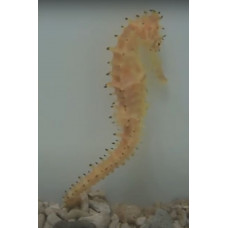Latin name
Hippocampus histrix
Other names
Thorny seahorse
Identification
It has a slender, elongated, and fully spined body. They are sharp, with dark tips, and arranged on a stubby tail of the same size. The body is covered with long spines that reach the corolla, which is composed of 4-5 spines. The head is also provided with numerous spines, especially on the forehead, at the base of the cheeks, on the nose and above the eyes. The muzzle is very long and pointed.
Features of fish fins
Dorsal spines (total): 0; Dorsal soft rays (total): 15-18; Anal spines: 0; Anal soft rays: 4.
Fish colouring
Body coloration varies greatly depending on the environment, ranging from gray to cream, pale yellow to green, red, and even brownish. It can be solid or with various patterns on the sides and/or back. The snout is usually striped, with one or more thin white stripes.
Distribution
A relatively rare species, but widely distributed throughout the Indo-Pacific region. In Australia, it has been found south of Ashmore Reef in the Timor Sea, on the Great Barrier Reef in Queensland, and in Port Stephens, New South Wales. It is also found in Bali, Indonesia, Papua New Guinea, Japan, New Caledonia and Indonesia.
Habitat
A tropical marine species. Prefers relatively deep waters (10-95 m) and is usually found at depths down to 15 m. It inhabits a variety of substrates, including sponges, algae-covered rocky reefs, soft corals, but especially seagrass beds.
Size
Males have a maximum length of 17 cm.
Behavior
They live among thickets of algae or in seagrass beds and do not migrate.
Food and feeding habits
Are carnivorous marine animals that feed on small crustaceans and other planktonic organisms.
Reproduction
Oviparous, the female uses the ovipositor to transfer the eggs to a closed pouch under the male's abdomen. It is the male that incubates the eggs in his abdominal brood pouch. The sac is composed of capillary-rich villi that surround each fertilized egg, forming a kind of placenta that nourishes the embryos. The male fertilizes the eggs in the sac and provides physical protection as they develop. He also controls the osmoregulators, aerates the embryos, and may provide some nutrition until the offspring are born. When the fry are fully grown, they are expelled from the nest and develop in complete autonomy.
Fishing
They are harvested for the aquarium trade as they inhabit moderate depths.
Relationship with a person
They are most commonly used in dried form and sold for medicinal purposes or as souvenirs. Seahorse dishes can be found in the cuisines of East and Southeast Asia.
Interesting Facts
The Spiny seahorse produces clicking sounds while feeding. During courtship, the males typically click louder than the females, but the sound is quiet enough to avoid alerting nearby predators.
| Classification | |
| Phylum | Chordata |
| Class | Actinopterygii |
| Squad | Syngnathiformes |
| Family | Syngnathidae |
| Genus | Hippocampus |
| Species | H. histrix |
| Features | |
| Conservation status | Vulnerable |
| Habitat | Pelagic |
| Life span, years | No information |
| Maximum body weight, kg | No information |
| Maximum length, cm | 17 |
| Sailing speed, m/s | No information |
| Threat to people | Edible |
| Way of eating | Planktonophage |
Spiny seahorse
Tags: spiny seahorse



